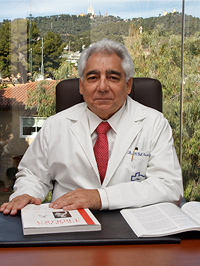

Láseres en el tratamiento de la hiperplasia benigna de próstata
En el año 1996, la FDA (agencia norteamericana responsable de la regulación de procedimientos médicos) aprobó el láser para el tratamiento de la HBP obstructiva (hiperplasia benigna de próstata). Desde entonces, se han desarrollado muchos tipos de láseres. La destrucción del tejido prostático obstructivo (HBP) mediante estas técnicas se basa en la generación de energía térmica que, conducida a través de una fibra introducida por la uretra, se aprovecha para cortar, coagular y vaporizar el tejido, convirtiéndolo en CO2 y vapor de agua.
En la actualidad, los láseres más utilizados son el Ho:YAG (láser de holmio), el KTP (láser de potasio titanil fosfato o láser verde), el LBO (láser de triborato de litio) y el SCD (láser de diodo semiconductor).
Se utiliza una fibra que permite cortar y vaporizar el tejido de manera simultánea. De este modo, es posible su utilización en próstatas grandes. El tejido de HBP es seccionado en 2 o 3 fragmentos que luego, por medio de un triturador, son fragmentados en pequeños trozos que después son extraídos.
La ventaja de esta técnica es que se pueden tratar pacientes que reciben tratamiento anticoagulante y con próstatas de gran tamaño como en la cirugía abierta, pero con mucho menor sangrado y con un tiempo de hospitalización más corto (entre 1 y 2 días). En el tratamiento de próstatas de menor tamaño, esta técnica láser no aporta ventajas sobre la resección transuretral de la próstata (RTU).
El KTP se conoce popularmente como "láser verde" y trabaja con una energía máxima de 80 W, mientras que el LBO alcanza los 120 W. Ambas técnicas permiten una adecuada destrucción del tejido mediante vaporización.
El procedimiento puede ser monitorizado mediante ecografía prostática endorrectal, técnica en la que fuimos pioneros y practicamos desde 2007, lo que nos permite un seguimiento preciso del proceso de fotovaporización. La tasa de vaporización aproximada es de 6 gramos en 10 minutos. Se puede utilizar en próstatas de hasta 80 gramos de peso y en pacientes que reciben tratamiento anticoagulante. A las 24 horas de la intervención se retira la sonda uretral y el paciente recibe el alta.
El láser de diodo también se denomina "láser rojo". Este láser requiere una energía máxima de 120 W y su principal ventaja es que tiene la tasa de vaporización más alta, llegando a destruir 7 gramos en 10 minutos, así como una coagulación más potente que los otros modelos de láser. Se pueden tratar próstatas de hasta 80 gramos de peso y el procedimiento puede ser monitorizado mediante control ecográfico. A las 24 horas de la operación se retira la sonda vesical y el paciente recibe el alta.
 La ablación prostática con etanol consiste en inyectar alcohol absoluto anhidro (etanol) en la próstata, ya sea en forma líquida o de gel, a través de la uretra o del periné. El alcohol produce una destrucción de la HBP y se puede aplicar en próstatas de gran tamaño. Es un procedimiento muy rápido (15-20 minutos) y puede practicarse en pacientes con patologías concomitantes severas y que no pueden ser sometidos a una anestesia profunda y prolongada. Se realiza bajo anestesia local o sedación endovenosa y bajo control ecográfico.
La ablación prostática con etanol consiste en inyectar alcohol absoluto anhidro (etanol) en la próstata, ya sea en forma líquida o de gel, a través de la uretra o del periné. El alcohol produce una destrucción de la HBP y se puede aplicar en próstatas de gran tamaño. Es un procedimiento muy rápido (15-20 minutos) y puede practicarse en pacientes con patologías concomitantes severas y que no pueden ser sometidos a una anestesia profunda y prolongada. Se realiza bajo anestesia local o sedación endovenosa y bajo control ecográfico. 
El paciente es dado de alta el mismo día. La sonda uretral se mantiene entre 5 y 7 días. Un 26% de los pacientes necesitan ser reintervenidos a los 3 años del procedimiento.



































